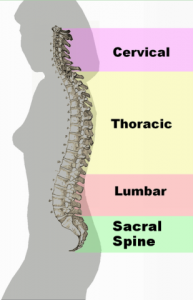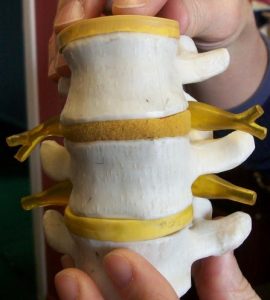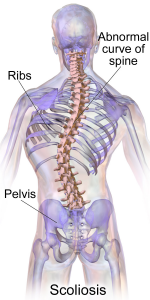Spinal Anatomy 101
Learn More About Your Spine
An explanation of how its shape may be affecting your health
At the Pain and Posture Wellness Centre we work primarily with your spine. We use our hands to gently push back bones that have gone out of place in a forward direction. The reason why “forward” is bad is that your body does not have muscles that can pull these bones straight back into position. To understand more about what we do or what we mean when we say we will work on your “C7” or “L5”, or when we say your spine has gone “flat”, it is helpful to have a look at what a normal human spine looks like.
The bony parts of the spine
Your spine is composed of 24 bones called vertebrae. Starting at the top, there are 7 neck bones. The first two of these have special names: “atlas” – because the top bone carries the skull; and “axis” – because the second bone allows you to turn your head. The 7 cervical vertebrae are numbered C1 to C7. So when we refer to “C7”, we mean the lowest bone in your neck, right at your neck/shoulder junction. If this bone goes out “forward”, it causes your neck to stick out. If it goes forward really far and compensatory changes occur, it can cause the formation of a hump in your neck/shoulder junction.
Next come 12 thoracic vertebrae (T1-T12) which form your mid-back. And then you have 5 vertebrae in your lower back or lumbar spine. These are numbered L1-L5. So when we say we need to work on your L5, we mean the lowest bone in your lumbar spine. Below this, at the base of the spine, is a bony plate called the sacrum. This is made of 5 fused vertebrae. The bottom part of your spine is the coccyx or tailbone, which is a small set of 3-5 partially fused vertebrae. Adding the sacrum and coccyx, your spine has 33 bones altogether.

The spinal cord and discs
In addition to holding you upright, the spinal column protects your spinal cord. This long bundle of nerves starts at the base of your brain (called the brainstem) and travels down within the spinal canal which is formed by the back parts of the vertebrae. In between each pair of spinal bones, nerves exit the spinal cord and carry messages to every part of the body.
The individual vertebrae are separated from each other by discs which provide padding and shock absorption as your body moves. Each vertebra connects to the one above and below via small joints and thus creates a movable unit. If a bone moves out of position, these joints can become “stuck”, which can eventually lead to misalignments in your entire spine. This is the main cause of bad posture. This, in turn, can lead to an increase in mechanical pressure on some parts of your spine. If they take an x-ray or MRI, the doctors can see these structural changes to the bones and discs. They often call them “thinning” or “bulging” of the discs, “arthritis”, “spinal degeneration” or simply “wear and tear”.

Understanding the shape of your spine
A healthy spine has a series of four natural curves, forming a “double-S” shape when viewed from the side. Viewed from behind or in front, your spine should look straight. This shape provides optimum strength and support to the body. A healthy spine holds you upright against gravity and evenly distributes the weight of your body – without you having to use your muscles to hold you up! If it were completely straight, your spine would have trouble supporting the weight of your body. The goal is to maximise stability with minimum energy-output. When all the spinal curves exist in their optimum shape, your spine is in a neutral position. The normal cervical curve is called “lordosis” (forward curve); the thoracic curve is called “kyphosis” (backward curve); the lumbar curve is another “lordosis”, and the sacrum and coccyx form another “kyphosis”.

As bones go out of alignment, you may lose the normal shape of these spinal curves. Your cervical curve may become flat as your head sticks out and your ear now sits in front of, rather than above, your shoulder. Your thoracic kyphosis may become exaggerated, leading to a hump in your upper or mid-back. And your lumbar lordosis may become increased too, leading to a hollow back. Alternatively, the cervical, thoracic, and lumbar curves may get reduced and become too straight; this is called a “military spine”. If your spine develops a sideways curve when viewed from behind, this is called “scoliosis”.

All of these different changes have one thing in common: ultimately, they mean that your body is not functioning at its best from a mechanical point of view. The weight gets distributed unevenly; muscles become tight; and degenerative changes may occur in the bones, joints, and discs. Abnormal spinal curves also cause your spinal cord to get stretched across the extra “kinks” in your spine. This can interfere with how the nerves function. All these changes may, for example, manifest as muscular pain, pins and needles in your arms or legs, or difficulty breathing (if e.g. the ribs aren’t moving correctly). You may experience balance problems, vertigo, or light-headedness. Your brain spends most of its energy simply on holding you upright against gravity. If it has to increase the energy needed to do this because your spine is out of alignment, you might feel tired or exhausted all the time.
Advanced Biostructural Correction™ can help!
The good news is that Advanced Biostructural Correction™ can help to restore the normal curves in your spine over time. This happens because we correct the position of the bones in your spine in relation to each other. As your bony structure gets corrected, your posture improves, movement will return to the “stuck” joints, nerve-stretching gets reduced, pain lessens, and the overall function of your body improves.
Why not book a free consultation to see how we can help you?




[…] we discussed the shape of a healthy spine, we observed that it has a series of curves that look like a double-S […]
[…] In either of these scenarios, a force acts on your spine from behind (i.e. the car seat slams your spine forward on impact). If a force acts on a curve – in this case the natural curve in your spine –, the curve flattens. Bones in your spine get moved into a “forward” direction, and your body has to compensate for these changes by purposely pulling other bones out of alignment. Your spinal curves change and become too flat overall. Doctors speak of a “straight” or “flat” spine or of “loss of cervical lordosis” or “loss of thoracic kyphosis”. To understand what lordosis and kyphosis mean, check out our previous post on spinal curves here. […]
[…] or from the front, the human spine should be straight. Viewed from the side, it should have a “Double-S” shape. In patients with scoliosis, the spine has an S or a C shape when viewed from the front or […]